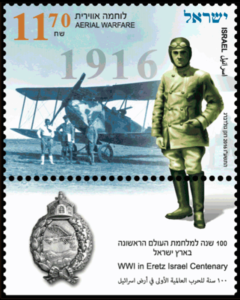 In October 1914, a few months after the outbreak of WWI, the Ottoman Empire aligned itself with Germany and Austria against the allied nations (Britain, France and Russia). The Great War, as it was called at the time, lasted for more than four years and fundamentally changed the history of the world, including the situation of Eretz Israel. In early 1915, the Ottoman military waged a campaign in the Sinai Peninsula, intending to conquer the Suez Canal. But the attack failed and the Turks were forced to retreat back to Eretz Israel. During the retreat the Turkish force was attacked repeatedly by British aircraft stationed in the Suez Canal area and since it had no planes of its own, the Ottoman army was powerless against these strikes.
In October 1914, a few months after the outbreak of WWI, the Ottoman Empire aligned itself with Germany and Austria against the allied nations (Britain, France and Russia). The Great War, as it was called at the time, lasted for more than four years and fundamentally changed the history of the world, including the situation of Eretz Israel. In early 1915, the Ottoman military waged a campaign in the Sinai Peninsula, intending to conquer the Suez Canal. But the attack failed and the Turks were forced to retreat back to Eretz Israel. During the retreat the Turkish force was attacked repeatedly by British aircraft stationed in the Suez Canal area and since it had no planes of its own, the Ottoman army was powerless against these strikes.
The Turkish and German commanders learned from this experience, moving a force of 14 German Rumpler C-1 aircraft, which were superior to the British planes, to Eretz Israel to take part in the renewed efforts to attack the Suez Canal. The German squadron took up its post in Beer Sheba in April 1916. Even after the offensive failed, the German planes continued to bomb British forces as they steadily made their way to the southern border of Eretz Israel.
The aerial warfare continued and intensified in 1917-1918. Both sides sent new and more advanced aircraft to the front in Eretz Israel, such as the Rumpler C-IV that appears on the stamp. These aircraft fulfilled various missions including aerial photography, patrols and bombing and even the occasional aerial battle, such as that described by Ze’ev Jabotinsky in his memoirs: “Two aircraft faced each other, circling around an invisible centerÖ filling the air with the clatter of machine guns and flakes of white cotton.”
The Bavarian 304th squadron, which was posted at the Merhavia Cooperative from November 1917, became a renowned part of the history of the Jewish Yishuv. Strong bonds were formed between residents and squadron members, who aided one another and even held joint dances. The Bavarians actively assisted Merhavia members, shielded them from the injustices of the Ottoman authorities and even purchased military surplus mules and wagons for them. On one occasion, Bavarian aircraft bombed Sulam, a neighboring Arab village, in retaliation for the murder of one of the Jewish residents.
Description of the Stamp and First Day Cover
The stamp features a German pilot in uniform. In the background ñ a German plane on the landing strip by the Merhavia Cooperative ñ photo courtesy of the Library of Congress, American Colony collection. The tab features the emblem of a Prussian pilot.
The First Day Cover features a photo of the Merhavia Cooperative Barn Museum, a significant portion of which is dedicated to the close bond between the Jewish residents and members of the Bavarian squadron. Photo by Moshe Rimmer. The background features a British military map exhibiting plans for conquering the Merhavia area in September 1918. Photo courtesy of the National Library of Israel.
Technical Details:
Issue: June 21, 2016
Stamp Size (mm): H 30 x W 40
Plate: 1023
Stamps per Sheet: 15
Tabs per Sheet: 5
Method of printing: Offset
Security mark: Microtext
Printer: Cartor Security Printing, France.



